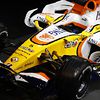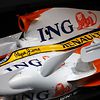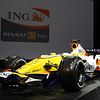R28 technical description

The ING Renault F1 Team today officially launched its 2008 season as it revealed the brand new Renault F1 R28 and its driver line-up at Renault’s communications headquarters in Boulogne-Billancourt, on the banks of the Seine in south-west Paris. Of course most of the attention went to the car which is completely different than the R27.
Renault F1 R28 Technical Description
Following the ING Renault F1 Team’s disappointing performance in 2007, the new R28 marks a change in design philosophy aimed at extracting maximum performance from the Bridgestone control tyres – and redressing the shortcomings of the ill-starred R27. The R27 was a conservative evolution of its predecessors, whose philosophy of rearward weight distribution and aero balance was perfectly tuned to the characteristics of the Michelin tyres used until the end of 2006. Testing during late 2006 and the early part of 2007 confirmed that major changes would be required to get the most from the standard Bridgestone tyres; this was further compounded by correlation problems between the wind tunnel and track performance, which caused unpredictable and inconsistent handling in the early part of the season.
Renault soon got down to work analysing and correcting its problems, a process it had completed by mid-season, but decided early in 2007 not to manufacture a ‘B-spec’ version of the R27 – in order to avoid compromising preparations for 2008. With this in mind, the team ceased development of the R27 during August in order to focus on a major change in concept for the new car. Launched later in January than previous Renaults, the R28 has benefited from the maximum possible development time in the wind tunnel and, in the words of Bob Bell, it is “much less evolutionary” than its predecessors. The car’s most obvious architectural difference is the adoption of a “zero-keel” front suspension mounting. 2007 was the first season in which a zero keel car won the championship and although the team had investigated the solution on numerous occasions, this was the first time that it offered real aerodynamic gains in the tunnel. The team says that the configuration opened up new aerodynamic development paths, rather than being a net gain in itself, and it has worked hard to retain the forgiving mechanical configuration of previous cars in spite of the change.
One look at the R28 demonstrates that the front end of the car has come in for particular attention. The forward weight distribution and aero balance demanded by the Bridgestone tyres mean this zone is now of critical importance, and the team has found some radical solutions. The tri-plane front wing – a first for Renault – also features a bridge wing across the now-lower nose and an innovative arrangement for attaching the mainplane to the nosecone, which gives the car a distinctive ‘open-mouthed’ appearance from the front. Both front and rear wheels have adopted fairings, taking the concept a step further than the “witches’ hats” run last year on the rear wheels only.
The monocoque has undergone a number of detail modifications with subtle surfacing from every angle, and the sidepods feature even smaller openings and more extreme undercuts than on the R27. With the cooling requirements of the homologated RS27 engine well-known, the team has felt confident to push the car’s packaging to even greater extremes. The mirrors now sit in-board, closer to the cockpit, removing one of the most distinctive features of its predecessor; under the previous arrangement, visibility could have been compromised by the new extended driver head protection on the cockpit sides.
The bodywork appendages stay faithful to the pod wing/chimney/T-wing arrangement of previous Renaults. The rear bodywork is even more tightly packaged than on its predecessors, to optimise airflow to the rear wing, while the wing itself retains the centrallysupported design introduced on the R26 to save weight without compromising rigidity.
Under the skin, the team has worked hard on saving weight to increase the ballast available for tuning set-up from circuit to circuit; and on improving stiffness throughout the car, maintaining the characteristic arrangement of struts between the chassis and gearbox that first appeared with the introduction of the wide-angle V10 engine in 2001. The four-race gearbox once again has a titanium main case, and the team says that the transition to control systems allowed by the SECU has been performance-neutral in terms of the speed of its “quick-shift” mechanism.
Renault began preparations for the SECU over a year before the car first ran, and was one of the first teams to track test the 2008-spec MES-designed unit, at Monza in September last year. In spite of some significant teething troubles, the team has worked hard through the winter to optimise performance and package the unit’s unusual triangular design. Unlike some other teams, Renault has not revised its approach to vehicle dynamics following the loss of traction control and engine braking control. The team argues that a car needs sound mechanical handling with or without control systems, and believes that any changes required can be contained within its traditional set-up parameters.







